Belize City, San Salvador, San José, México D.F., March/April 2013
photos by G.P. Jones using Nikon Coolpix 4300 digital
camera, except where noted

Itinerary, from Los Angeles (via Houston) to Belize City, and beyond.
Belize City, 26-29 March 2013

Belize was known as British Honduras until 1973, when it changed its name in anticipation of its independence from Britain in 1981. This doorway on a public building near the town center bears the insignia of George V, who was King of England (&c.) from 1910 until 1936.

This mailbox is a curiosity. It is obviously a "QE2" mailbox, but the Queen's original insignia (see comparison photo) appears to have been changed to "F-H-R". (The original insignia, "E II R", stands for Elizabeth II Regina. I can't imagine what "F H R" stands for!)

Belizean back yard, complete with cistern and bathtub.

Anyone who has seen some of my other travel pictures knows of my (perverted?) fascination for "Stairways to Nowhere". Belize seems to have more than its share.
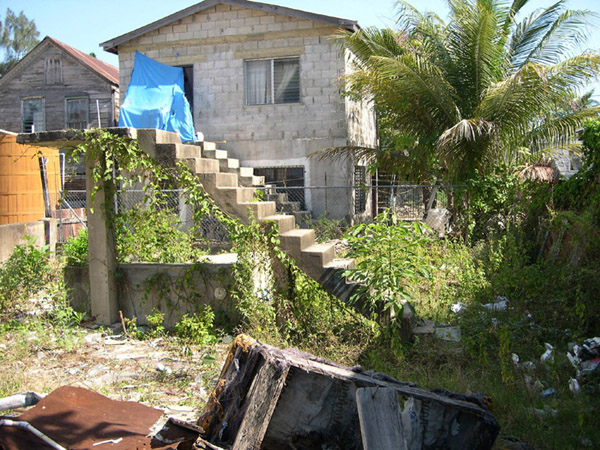

This is particularly interesting, as the stairway goes to the door on the second floor, but then continues to nowhere at roof level. (My guess is that the original plans had three [or more] floors for this house.)

Fort Point Lighthouse, Belize City.

Like many old buildings in this and other long-established cities, plants sometimes take root in the walls well above ground level. This is St John's Cathedral in Belize City.
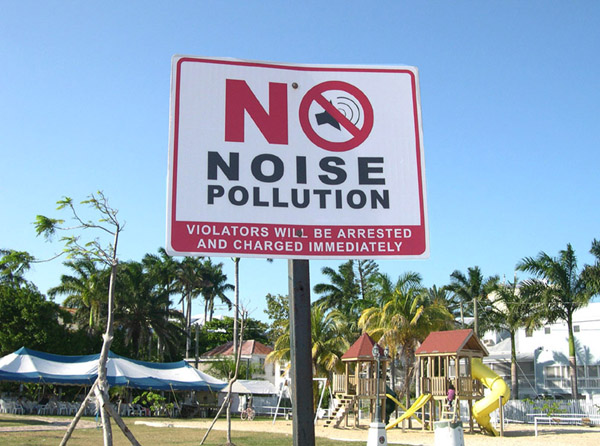
One of the most interesting features of Belize City was the variety of signs posted around town. This one is particularly significant to me, as the noise of modern society is, in my opinion, one of our biggest "quality-of-life" problems, not far behind global warming, air pollution, and people using cell phones in quiet restaurants.

The heading "Obvious Statement" on this sign can only mean that anyone who doesn't already know not to park here is really, really stupid.

How can one deal with this subject delicately? Belizean women, on average, are, well, hefty. What store in the U.S. or Britain would advertise the fact that they have sizes ranging from XS to XXXXXL? During April there are ads throughout the city for the Miss Plus Belize pageant. Good for them. They celebrate their curves, and have a dress shop to prove it.
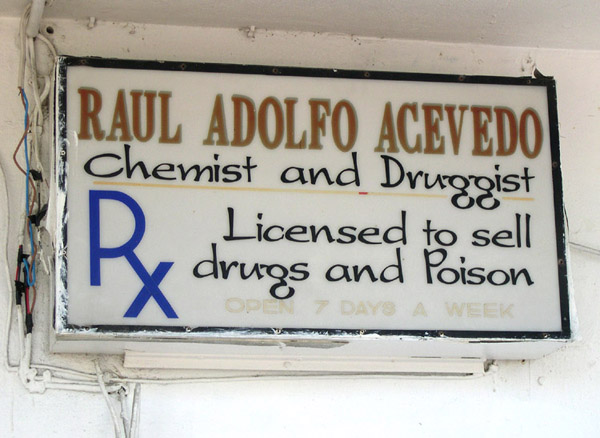
This was one of many such signs at similar stores around the City. It seems to be one of those expressions that is common to Belizeans, while looking strange, even sinister, to foreigners (like me).

There are lots of possible interpretations of this language. I'll leave it up to the reader to find one or two (or three) without my help.

On reading this sign once I got home, I realize that the "Special" probably has more food in it, hence the higher price. On first glance, however, it seemed to be saying that the Easter treat was $1.50, but this week only it was on special for $2.00. (This, by the way, is Belizean dollars; to convert to U.S. dollars, divide the amounts in half.)
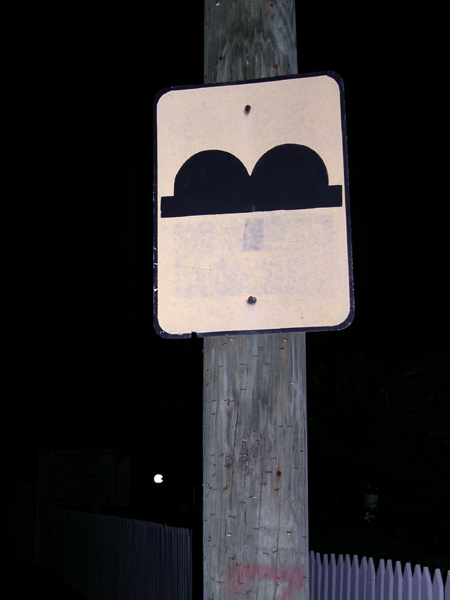
Well, I guess this is self-explanatory. I hope so, anyway.
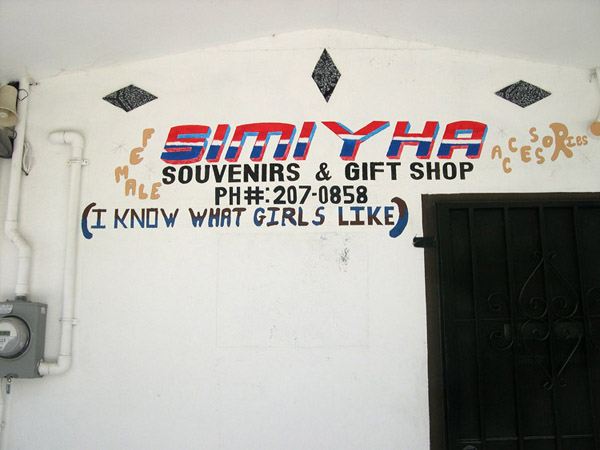
The operator of this boutique seems pretty self-assured. I wonder if it's a man!!?

One of the better restaurants in Belize City is on a small peninsula called Bird's Isle, which is accessed by a long dirt road. This and the next two signs are posted along the road, like the old Burma Shave signs, but without a punch-line.

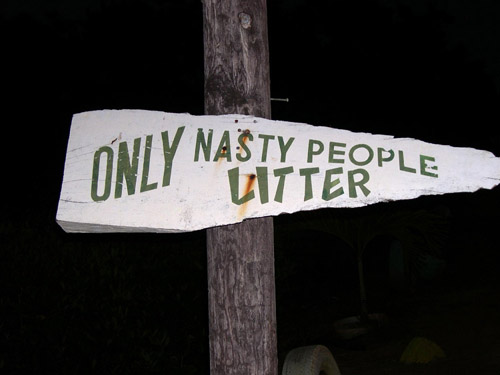

What can one say about the illustrious Isiah Emmanuel Morter that hasn't already been said about stomped-on toad frogs?

Architecture in Belize City is a notch or two below, say, New York, or even Paducah, Kentucky. A few buildings, however, do stand out, even more so because of the humble surroundings. This is the Wesley Methodist Church.

Wesley Methodist seems to me to have clear Art Deco features, so I was surprised to find that it was built in 1950 (at least 15 years after the "end" of Art Deco in the larger cities of Europe and America).

The Methodist Motto, seen here, may be interpreted by elders as "guidance", while some Methodist teens might view it as "restriction". I feel sure the original intent was the former.
San Salvador, 29 March-3 April 2013

The Iglesia del Calvario, in Olocuilta, El Salvador can be seen from the carretera between the airport and San Salvador. The town is famous as the birthplace of El Salvador's signature food, pupusas. Actually, it is the birthplace of pupusas that are made with rice flour, not wheat flour. So says my taxi driver. In any case, they're delicious -- and cheap.

Here we see the primary symbols of San Salvador: the Monumento al Divino Salvador del Mundo (1942) on the right, rampant commercialism symbolized by McDonald's, and the looming presence of San Salvador volcano, one of 22 within El Salvador. The one seen here last erupted in 1917. Is it overdue? The people I talked to didn't seem too worried.

Art Deco can be seen in many areas of San Salvador. This example (if memory serves) is in the Alameda Franklin Delano Roosevelt, near Parque Cuscatlan.
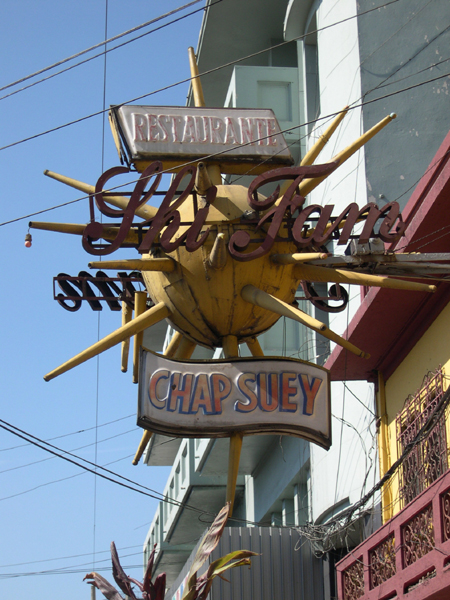
Being used to "chop suey", this spelling looks funny to me, begging for bad jokes. I have, however, seen the same spelling in other Mexican cities. It's an Asian dish, after all, and they spell it like they hear it.

Lenin was entombed in glass in Red Square. Walt Disney (reportedly) was cryogenically frozen. Would it be so hard to believe that Col. Sanders was stuffed, and propped up on a bench in San Salvador?

Oh, man, I've got some friends who would not find this amusing.

I've also got some other friends who would find this totally amusing.

The only remaining question is, do they serve Hot Dogs? (I don't think so.)

This isn't really a typical El Salvador scene, just a very clever ad in the San Salvador International Airport.
San José, 3-9 April 2013

Correos (Post Office) building, Centro, San José.

As my readers know, I'm obsessed with Art Deco. This building, which bears the inscription "Año 1932", is South of the Centro, near the Iglesia de Nuestra Señora de la Merced.

In the same neighborhood (Merced), the Hotel Talamanca's Art Deco façade faces Avenida Segunda.

Just around the corner from the two buildings above is this well-maintained Deco building housing the Instituto Nacional de Seguros Sucursal de Merced.

Antigua Botica Solera, at intersection of Calles 8 and 10 in the Barrio México district. This building, which dates from 1932, is reminiscent of New York's Flatiron Building (1902), and other lesser buildings at similar intersections in many other cities in the world.

This appears to be a private house, and has a most interesting sort of extension, made of carved wood.

A close-up shows the detail of this house's remarkable feature. The house is across from the Iglesia Santa Teresita, at the corner of Avenida 9 and Calle Ismael Murillo.

There are many, many parks and sculptures throughout San José. Here is a side panel on a monument to Julio Acosta Garcia, Costa Rica's president from 1920 to 1924, in the Parque Morazán. It is remarkable because all the children apparently are boys and all the adults women. There seems to be no explanation as to the meaning or symbolism of this grouping. The main sculpture of Acosta Garcia himself (above and to the right) is signed "L[eoni]. Tommasi, 1962".

Costa Rica, like México and other Latin American cultures, maintains a fascination with Los Muertos, especially as symbolized in skeletons. The front of this children's theatre is dominated by a grinning grotesque that would likely not be featured on a Kid's Playhouse in the San Fernando Valley of California, for example.
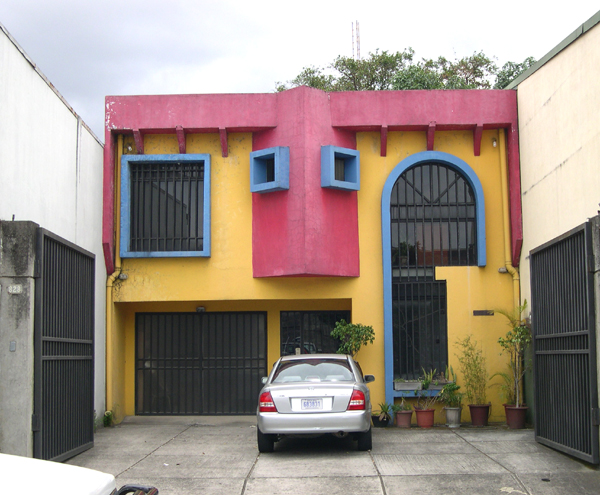
An interesting home (?) next to the Teatro Triciclo, shown above.

Perhaps the most elegant building in San José is the Teatro Nacional. The statue at the top is reproduced, full-size, in the Salon on the second floor of the building. The tour guide said one was the original, the other a copy.
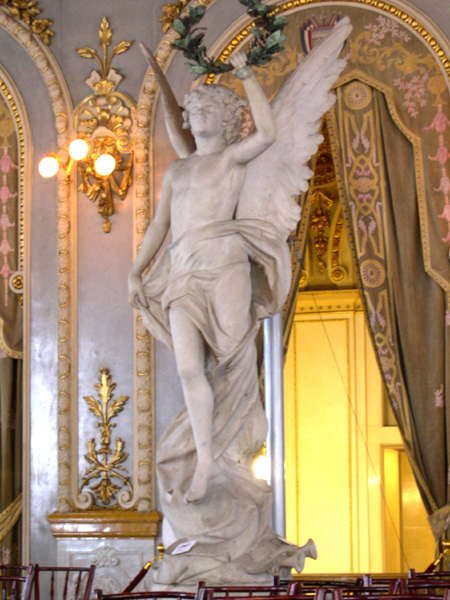
I think the one inside, shown here, is the original, but I could be mistaken.

This picture, from elsewhere on the Web (not my camera), shows just how opulent this theatre is. It opened in 1897, and is still in continuous use. I heard their National Orchestra play Stravinsky's Le Sacre du Printemps there during my visit, the performance commemorating the 100th anniversary of the Paris premiere of the Stravinsky piece.

Patrons of this restaurant are warned: CCTV is in operation, and (how should I translate this?) affectionate displays are forbidden. One wonders just why such a rule had to be implemented in the first place!
México, D.F., 9-16 April 2013

Mexico City has been waiting for my triumphant return there after nearly half a century. My first visit there was in 1963, a driving trip with two families (seven people) in one car. (Yes, we were still friends after the trip.) The second trip was to attend and sing at my college friend's wedding in 1965. In the intervening 48 years, I imagine the people of this great city wondered if I'd ever come back.
The Catedral Metropolitana was old then, and it's still old, but holding up quite well. We see it here behind an enormous flag. This is not an optical illusion. The flag is in the middle of the Zócalo, about halfway between where I'm standing and the Catedral itself.

Construction of the Catedral Metropolitana de la Asunción de Maria was begun in 1573 and consecrated on 2 Febrero 1656, while, like most Cathedrals, construction continued until the restoration efforts began. The Conquistadores chose Tenochtitlán as the location for their Catedral, the site of the much more ancient Templo Mayor (see below), in part so that they could take apart the Templo Mayor and use the materials in building their new Church.
The Catedral has an impressive look, don't you think? And this is just the side entrance (East). Actually, this is the side entrance to an adjunct of the Catedral called the Sagrario -- sort of a glorified Chapel. Point of interest: one cannot enter the Sagrario wearing shorts.

Human history is characterized by increasing elaboration, adding on to what was simple in the beginning. That's how this, the main altar of the Catedral, became so ornate fifteen centuries after a manger in a stable outside Bethlehem.
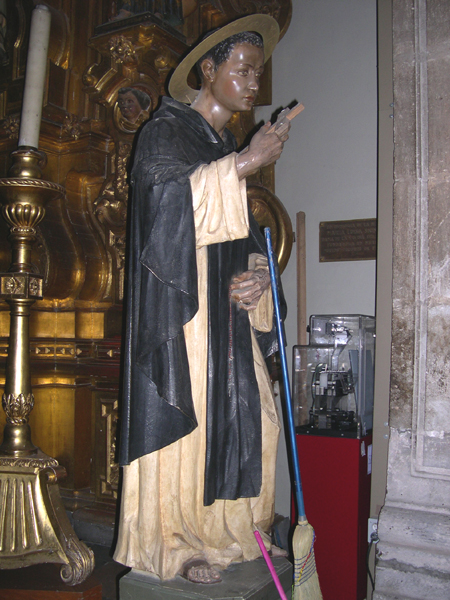
San Martin de Porres (1579-1639), was born in Peru to a Spanish gentleman and a black "freed-woman" from Panamá who, for the record, were not married at the time. Martin de Porres is one of the most venerated Saints in México. The broom is not a standard feature of this Chapel, nor of the other icons of this holy man.
[CORRECTION, added 2017-01-17: My grave mistake: the broom is, in fact, a standard feature of chapels and images of San Martin de Porres, symbolising his work on behalf of the poor and his belief that all work was sacred, no matter how menial. Boy, is my face roja!]

At the time of my previous visits (1963 and 1965, noted above) the Templo Mayor was still hidden under a block of modern buildings. In 1978, some electrical company workers were excavating near the Catedral, and found some relics that pre-dated the Conquistadores. The rest is digging history.
The first building of the Templo Mayor complex was begun sometime around 1325. Most accounts credit Aztecs with its construction, others say it was built by the Mexica people, one particular tribe of what is often referred to as the Aztec Empire.
If we want to be pretentious, we can call this the "tres épocas" photo, as we see the Templo Mayor (begun in 1325) in the foreground, in front of the Catedral Metropolitana (begun in 1573), and in the far background the top of the Torre Latinoamericana (begun in 1948, completed in 1956).

On my last visit in 1965, people were speaking of the Torre Latinoamericana as Mexico City's most modern building. As one can see from this photo, it is an almost-exact knockoff of the Empire State Building in New York, albeit less than half as tall (44 stories, while Empire State has 102). It also bears strong resemblance to New York City's iconic Chrysler Building, except of course for the unique Art Deco crown. The similarity in design could not have been coincidental.

The "House of Tiles" (Casa de los Azulejos) dates from the XVIII Century. Today it is occupied by a Sanborn's franchise, Mexico's equivalent of, say, J.C. Penney's or a glorified Woolworth's.

The tiles are from the State of Puebla, and were not cheap. Legend has it that they were added just to show the owner's father that, contrary to his father's predictions, he could amount to something after all.
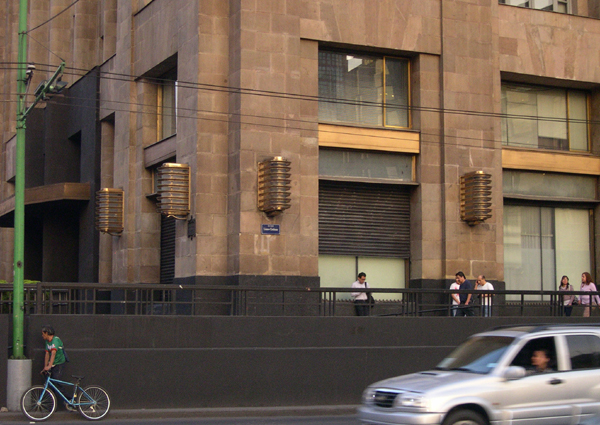
This building is pretty pedestrian in design, except for these impressive Art Deco lamps around the ground floor.
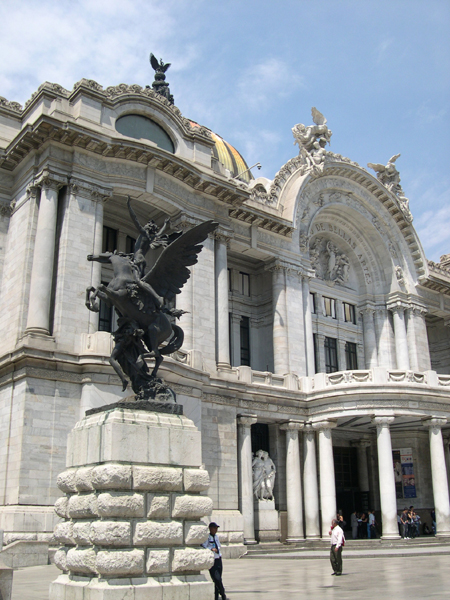
The fascinating Palacio de Bellas Artes is like a Hollywood actress: the outside appearance is totally different from what is inside.

The reason for the striking difference in outside and inside appearance of this masterpiece is, quite simply, the Mexican Revolution, which, in 1913, interrupted the work begun in 1904 under the original architect's design, which is mainly Art Nouveau. Work was resumed in 1932 and completed in 1934, fitting the interior almost completely in Art Deco style (which, as we know, wasn't even "invented" until the Paris Exposition of 1925).

The interior has lots of marble and brass . . .

. . . and features a three-story atrium lobby.

The image of the Virgin of Guadalupe is, by far, Mexico's most revered icon, perhaps even more often seen than the eagle eating the snake or Mexico City's symbol, the Ángel de Oro (see below).
The Guadalupe legend is similar to several other sightings of the Virgin Mother (Mary) around the world, except that in this one, it was a young man, not a young woman or child, who saw the vision. (Apparently the only other sighting by a man was in Rome, in 1842. See marypages.com/ for a [presumably] complete report.)
On 9 December 1531, Juan Diego saw the vision, which was imprinted on his apron or cloak (the fabric and image together are referred to as the tilma) as a sign to the skeptical bishop that a temple should be built at Tlayacac in Cuauhtitlan, about 20 km. (14 miles) North of Tenochtitlán (today's Mexico City). The temple, officially known as Templo Expiatorio a Cristo Rey was begun in 1531. It is now a Basilica, having been consecrated as such by Pope Pius X in 1904.
Here, in the middle, leaning forward, you see the original Basilica as it looks today. It is leaning because it is sinking into the ground. The area, like most of Mexico City, is a former lake bed. The modern building at the left is the Nueva Basilica, finished in 1976.

This picture is a PANORAMA of the entire plaza as it looks today.
To see the entire photo, scroll RIGHT.

Here is another view of the Nueva Basilica, from behind a statue that can only be one of Pope John Paul II, a very popular figure in Mexico. He visited the Basilica five (5) times during his papacy.
As for the actual tilma of Juan Diego, it was on display in the original Basilica (I saw it there in 1965) from 1709 until 1974, having survived a bomb planted in 1921 near the altar, which seriously damaged the church, but not the image of the Virgin, enshrined some distance away from the blast. The tilma is now in a quite modern shrine inside the Nueva Basilica. To view it, as I did along with my tour guide, one steps on a motorized walkway, rather like those in airports, to keep the flow of visitors moving.

The visit to the Shrine and Basilica of Guadalupe was part of a larger day-trip that ultimately took us to Teotihuacan, the site of a city with at least 2,200 years of history, so far. On the way, we made the obligatory "souvenir stop", where one of the authentic features were these strange, hairless dogs, known as "perros aztecos". I must say, they really did look authentic -- and leathery. (Later, in Mexico City along the fashionable Alameda, I saw an elegant woman walking a dog just like these, somewhat diluting my belief in the authenticity of these; but I digress.)

This view of the Pyramid of the Sun is from a less-used approach on the SouthEast side, for those who visit the nearby museum. This, to me, looks authentic. As I explain and illustrate below, much of the rest of Teotihuacan, except for the main pyramids themselves, doesn't quite come up to this appearance of realism.

This view from the SouthWest side of the Pyramid of the Sun, you can get an idea just how massive a structure it is, the base almost identical in size to that of the Great Pyramid of Giza in Egypt.

The great North-South axis of the ancient city is referred to as Calzada de los Muertos. Here we are looking almost due North, with the Pyramid of the Moon at the end, and the Pyramid of the Sun (not the one with the stairway, but beyond that) on the right.

Further up the Calzada de los Muertos, the Pyramid of the Moon dominates, with smaller structures -- not yet uncovered on my previous visit in 1965, if memory serves -- on both sides of the great Avenue. Almost all of the people in this scene, by the way, are souvenir vendors, not tourists.

I went to Teotihuacan in 1965 to see the two great pyramids and other buildings. My memory is somewhat hazy, but to my eyes today, it looks to me like much of the site has been built (not re-built, mind you) by theme-park engineers. It's just a little too square and perfect, as we see here in structures around the Plaza of the Moon. Even the steps on the Pyramid of the Moon itself seem like very modern additions.

Back in the Centro Historico, stands like this are all over town, offering bicycles which can be rented here, and left at your destination, in a brilliant scheme known as EcoBici. Many Mexicans (mostly young and physically fit, of course) use this mode of transportation around the city. The presence of the "muerto" (¿"muerta"?) at this particular location on the edge of the Alameda is fascinating and, at least to me, mysterious. What can it mean?

CLASSIFIED AD - FOR RENT: fifth-floor walk-up, near Piño Suarez
Metro station, great view, good ventilation, muy barato.
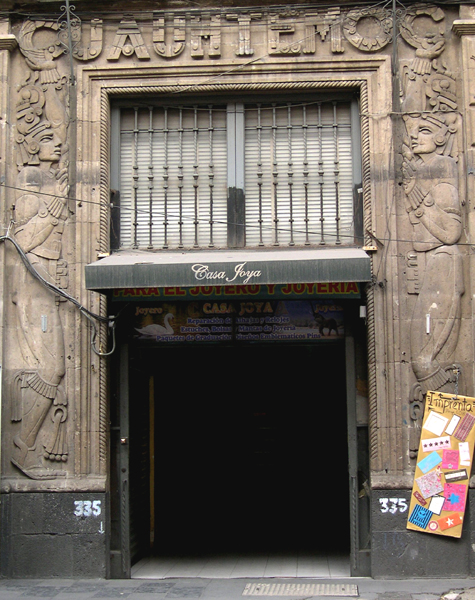
This must be a modern doorway, but, except for the unsightly wires and posters tacked on, looks like a once-elegant tribute to Cuauhtemoc.

Speaking of doorways, this one is, as they used to say in the 1970s, "tubular, man".
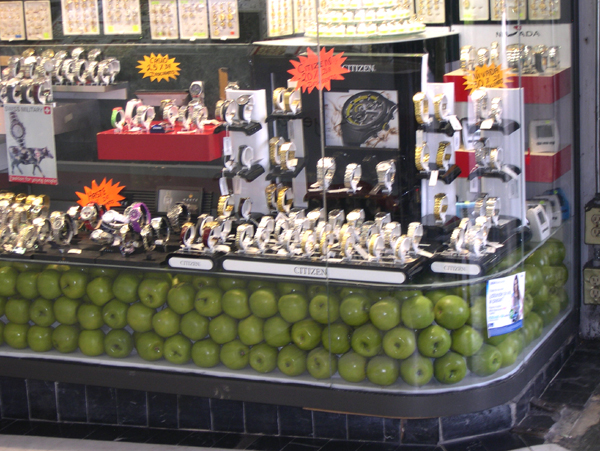
The only explanation I can think of for this is that the spirit of the absurd must be alive and well in México. This joyeria, just off the Zócalo, has a top display case full of rings and watches and below that -- yes -- green apples.

Language is a wonderful thing, as this sign shows. "Anillos de Compromiso" as used here means "promise rings", or what we often call engagement rings, while cynics like me can read it literally as "rings of compromise".

This sign is (probably) men's-room only, and tells the visitor to "Urinate happy and content, but always inside". The double meaning is interesting: "adentro" can mean inside the porcelain, of course, but also could mean "inside" as opposed to "outside" (the building).

Now we come to "pendejos". How can I explain this? It is Mexican slang, so it can only be approximated in English. I'll approximate it by saying that it means, "idiot". ("Asshole" is really more like it. Oops.)
Having gone that far, I might as well translate the rest (as best I can).
No.1: Pendejo -- it's not only a word, it's a way of life!
No.2: If the Pendejos could fly . . . this city would be an airport.
(I think this one's my favorite.)
No.3: (This one takes a bit of translator's license, as "metiche", like "pendejo", is pretty slangy): Of the 100 problems I have . . . one is for [being] pendejo, and 99 are for [being] nosy.
Now, you can feel free to imagine me, at the vendor's stall across the street from the Catedral, falling on the ground after reading these.

Laughing out loud on a normal street in a foreign country is something I try to avoid, so as to maintain some level of respect for us turistas. I must say, however, that this sign, without a doubt, had the funniest phrase I ever saw in this great city. "Pinches aborijines" is nothing short of inspired, and is probably a completely new invention by the eccentric who placed it outside his stall in the Calle Fray Servando Teresa de Mier, South of the Centro Historico.
The first three lines of this sign (which I will clean up a bit in case there are children or prudes watching) say, "I ask you please, don't throw trash here, you worthless aborigines." (NOTE: having grown up with the word pinche being used all the time in our neighborhood, it seems ludicrous to translate it as "worthless", so if you want authenticity, do a Web search.)

The sign shown above was posted outside this unique shanty of a store. I never saw anyone inside, but according to some of the signs posted all over the stall, the proprietor calls himself Tio Bush, and he supposedly sells gum, soft drinks and candy through the small, barred window in the front. Something tells me his main occupation is discussing politics and social issues with anyone who will listen.

Here is some more Art Deco design. Occupying a commanding position in the Paseo de la Reforma, this is the Edificio El Moro (1938), more popularly known as the Loteria Nacional, as their offices are located inside.

Further down Reforma (i.e., to the SouthWest of the Loteria building) is the Hotel Fiesta Americana, featuring this monumental silver (chrome?) bas-relief, along with several others.

Finally, the gem of this great city, indeed it's symbol and icon -- the great Monumento a la Independencia, or Ángel de Oro.
This is the polaroid I took on my second visit to the city, on 23 June 1965, from the top of the Hotel Maria Isabel (now the Sheraton). View is almost directly to the South.
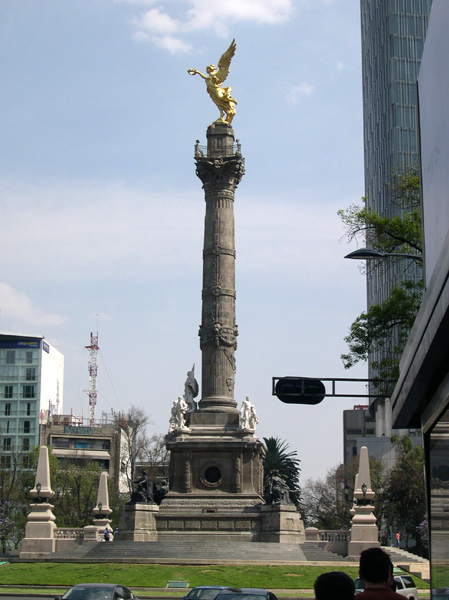
I'll never forget first seeing this stunning statue, which became immediately and remains to this day the most dazzling image in a city full of great sights and imagery.

I've come to the conclusion that it cannot adequately be photographed.

If the whole monument is included, the brilliant angel is too small, and without the column and base, it is just another beautiful gold statue. It can only be fully appreciated in person.

At the SouthWestern end of Maximiliano's great Paseo de la Reforma is the Bosque de Chapultepec, a very historic area, indeed. There in 1847, in the Castillo at the top of the hill, which at the time was being used as a Military Academy, six young cadets defied orders to withdraw, and died defending their Academy and their nation. Legend has it that at least one wrapped himself in the Mexican flag and jumped from the roof of the castle down the hill, so as to keep the flag from falling into enemy hands. The enemy, by the way, was the United States Army, led on that occasion by Gen. Winfield Scott.
The six are known as the Niños Héroes, and are among Mexico's most revered military heroes. They may not have been "niños" in a literal sense, but all were teenagers, ranging from thirteen to nineteen years old, when they died. This is the newer Monument to their memory, erected in 1952. It replaced an older memorial, on the same site, which was the scene of a remarkable, impromptu visit in 1947, exactly 100 years after the heroes' deaths, by U.S. president Harry S Truman, in which he laid a wreath and stood for a moment of silence in respect and tribute. One Mexican newspaper ran the headline, "FRIENDSHIP BEGAN TODAY". Fifty years later, president Bill Clinton repeated the gesture.

Considering the fact that this Monument dates from 1952, the obvious Art Deco feeling of the central statue and parts of the columns that (literally) stand for each of the six heroes has to be regarded as unusual. (I remind readers once again that Art Deco was popular in most parts of the developed world from its introduction at the Paris Exposition of 1925 until the late 1930s. This is another example, as noted elsewhere on this trip, of the use of Deco elements in Latin America considerably later than in Europe or the United States.)
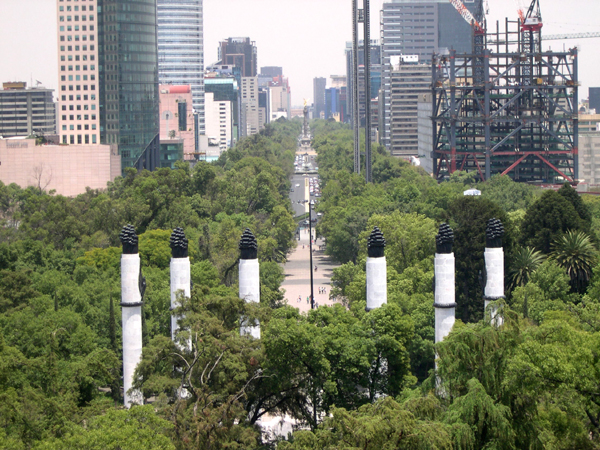
The Niños Héroes monument can also be seen from Chapultepec Castle, with Reforma stretching to the NorthEast, including the distant Ángel de Oro about in the middle of this view.

Far above the Monument at the foot of Chapultepec Hill, the Niños Héroes are further memorialized in statues at the very Castillo they defended with their lives.

In addition to these statues, seen from the second floor of the Castillo, just across the courtyard is a room containing memorabilia and six formal oil-on-canvas portraits by Santiago Hernández y Ayllón (1833-1908).

There is something quintessentially Mexican in this detail from the mural by Juan O'Gorman (1905-1982) titled Sufragio (1968), which covers an entire wall in the Museo Nacional de Historia in the Castillo de Chapultepec. The newspaper vendor thumbing his nose at the wealthy clearly expresses the attitude of the people toward would-be tyranny.

The Castillo de Chapultepec had many "guests" over the years, including, as noted above, military cadets. It was also the temporary home of the short-lived Emperor Maximiliano and his Empress Carlota. This formal garden is a bit too "cut and pruned" for my taste in gardens, but is remarkable as it is on the second floor (!) of the Castillo.

The Spanish word bosque means "forest", and the Bosque de Chapultepec certainly is that. I've know about this area, of course, since my first trip to Mexico in 1963, but I always thought that Chapultepec was some emperor or Aztec tribal leader who gave his name to the park. It was, in fact, a retreat for Aztec rulers long ago, but it turns out that Bosque de Chapultepec just means, "forest at grasshopper hill".

There are many, many references in Mexico City to uprisings, resistance, and what one might call "new politics". Paseo de la Reforma, Avenida Insurgentes, Avenida de la Republica, Plaza de la Constitución, and probably hundreds of streets named after revolutionary heroes such as Juárez or Hidalgo, and for significant dates of battles and resistance, such as 5 de Mayo, 20 de Noviembre and 5 de Febrero. In 1938, the city erected this brawny and clearly Art Deco Monumento a la Revolución, to commemorate the Revolution of 1910. It is also a mausoleum for some heroes of that conflict, such as Francisco 'Pancho' Villa, Lázaro Cárdenas, and others.

This monument is big, I mean Arc-de-Triomphe big, one of those things that you literally have to be several blocks away to photograph properly. At 67 metres high, it is, in fact, considerably taller than the Arc de Triomphe d'Étoile in Paris (a measly 50 metres). As if it weren't famous enough, on 4 December 2011, Britney Spears performed here as part of her Femme Fatale tour. OMG. At least the concert was free. Here ends today's history lesson. Adiós.